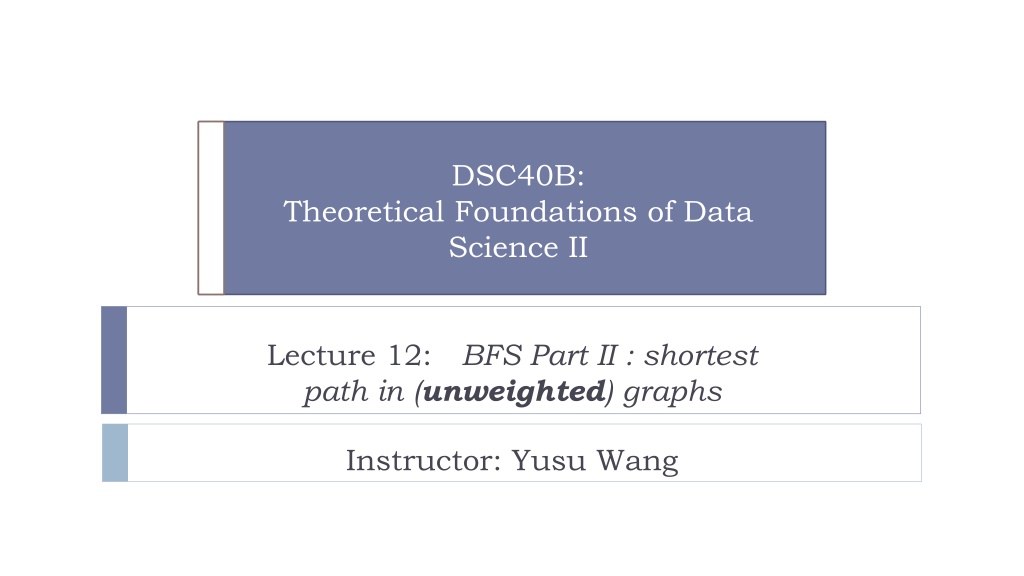
Shortest Path in Unweighted Graphs: BFS Exploration
Explore the properties of BFS (Breadth-first search) algorithm in finding the shortest path in unweighted graphs and understanding the key structures of shortest paths. Learn how BFS can be utilized to compute the shortest path distance in graphs efficiently.
Download Presentation

Please find below an Image/Link to download the presentation.
The content on the website is provided AS IS for your information and personal use only. It may not be sold, licensed, or shared on other websites without obtaining consent from the author. If you encounter any issues during the download, it is possible that the publisher has removed the file from their server.
You are allowed to download the files provided on this website for personal or commercial use, subject to the condition that they are used lawfully. All files are the property of their respective owners.
The content on the website is provided AS IS for your information and personal use only. It may not be sold, licensed, or shared on other websites without obtaining consent from the author.
E N D
Presentation Transcript
DSC40B: Theoretical Foundations of Data Science II Lecture 12: BFS Part II : shortest path in (unweighted) graphs Instructor: Yusu Wang
Previously: Introduced Breadth-first search (BFS) graph search algorithm Can be used to check for connectivity etc Today: Properties of BFS: Computing shortest path from a source node BFS tree
Shortest path in (unweighted) graphs
How to fly to Denver from Columbus using fewest number of connections
The length of a path is (#of nodes in this path 1) A shortest path from ? to ? is a path from ? to ? using with smallest possible length. Note that there may be multiple shortest paths from ? to ?, all of which has the same length. The shortest path distance from ? to ? is the length of a shortest path from ? to ? by convention, the distance is set to be + if there is no path from ? to ?
Input: A (directed or undirected) graph ? = (?,?) and a source node ? ? Output: The shortest path distance from ? to all other nodes in ?
Property of shortest paths (i) Claim A: Given any ?,? ?, if ? is reachable from ?, a shortest path from ? to ? has to be simple. (Recall, a path is simple if no node in it is visited more than once)
Property of shortest paths (ii) Key structure of shortest paths: Any sub-path of a shortest path must be a shortest path itself. This implies that a shortest path of length ? consists of a shortest path of length (? 1) plus one edge. e.g, given a shortest path ? = ?0,?1, ,?? 1,?? from ?0 to ??, it consists of a shortest path ?0,?1, ,?? 1 plus edge (?? 1,??)
Shortest path and BFS
How do we find shortest paths? High level idea: Starting from the source ? First find all nodes that are at distance 1 from ? Then use them to find those nodes at distance 2 from ? Then use them to find those nodes at distance 3 from ? . Till we find all reachable nodes Note: to get a node at distance ? from source ?, you have to first reach a node at distance ? 1 from ?, and extend it from that node via an edge.
It turns out that this idea is exactly what BFS is doing! Intuitively, the first time that we discover a node turns out to encode the fastest way to reach it that is also when we first change the status of a node from undiscovered to pending the time this node is discovered relates to the distance to the source nodes by visiting and exploring the oldest pending nodes (those with smallest distance to the source first), we find fastest way to reach a new node
Property of BFS For any ? 0, all nodes at distance ?from source are added to the pending queue before any node of distance > ? Hence nodes are added to the pending queue in increasing order of their distances to the source Therefore, nodes are processed (popped from the queue) in order of distance from the source, which further guarantees that the first time to find a undiscovered node, that must be the shortest path to reach this node from the source.
Consider a node ? that we just popped from the queue Suppose the distance from source ? to ? is ? Our algorithm will then scan through all neighbors of ?. For a neighbor ? of ?, we have now found a new path ? to reach ? by the path from ? to ?, followed by the edge (?,?). The length is ? + 1. If this neighbor ? is undiscovered then the new path ? must be shortest! Why? hence the shortest path distance from ? to ? is ? + 1 Otherwise, this neighbor ? is already discovered (pending or visited) then it means that we have already found a path to ? before, whose length is at most ? + 1. so, the new path ? we just found is not useful for shortest path we already have a shortest path to ?
But we can do more! We can record information to help us recover shortest paths themselves later! Node ? is set to be BFS-predecessor of ? if ? is discovered while visiting ?. This means that ? is the predecessor along a shortest path from the source ? to ? In particular, the shortest path from ? to ? plus edge (?,?) is a shortest path from ? to ? ! If all nodes remember their BFS-predecessors, Then we have enough information to recover shortest paths from the source ? to all reachable nodes!
Time complexity Note that this has the same asymptotic time complexity as BFS algorithm ? ? + ?
BFS Trees and recovering shortest paths
Results of BFS_shortest_path Every node reachable from the source has a single BFS-predecessor except for the source ? itself Connecting each node to its BFS-predecessor gives a rooted tree, where the source is the root in particular, the parent of each node in the tree is its BFS-predecessor This tree is called the BFS-tree associated to source ?
Trees A (free) tree is a connected graph ? = (?,?) where ? = ? 1. For any two nodes in a tree, there is only one simple path connecting them. A rooted tree has a root, and each node other than the root has a parent. The parent ? is the predecessor of ? along the unique simple path from the root to ? A collection of trees is called a forest.
BFS-tree BFS-tree associated to source ? can be used to recover both the shortest path and shortest path distance from ? to each reachable node. Example: Claim: Given a graph ? = (?,?), let ? be its BFS-tree from source ?. Then for the unique path from ? to ? in ? is a shortest path in ?, and its length is the shortest path distance from ? to ? in ?.
In general, if we run the full-BFS algorithm (with augmentation of computing also predecessors and distances), then we will obtain a collection of BFS-trees, called a BFS-forest. Example:
Summary BFS algorithm: It explores nodes in order of their first discovery time In particular, it will explore them in order of their shortest path distance to the source It will propagate a wavefront, first visit all nodes distance 1 to source, then distance 2, then distance 3, and so on So it explores as broad as possible before moving deeper (meaning further away from the source) Thus the name: breadth-first search. It can be used to compute the shortest path distance to a source node Time complexity is ?( ? + ? )






















